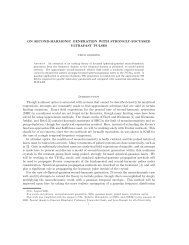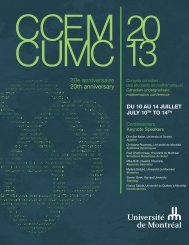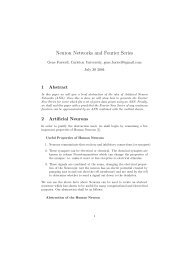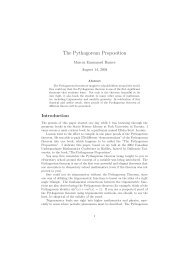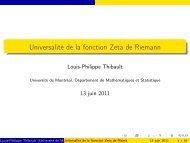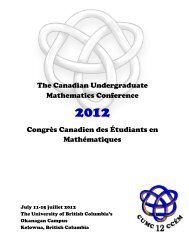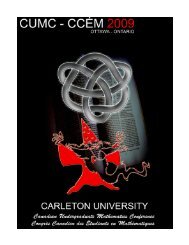booklet - CUMC - Canadian Mathematical Society
booklet - CUMC - Canadian Mathematical Society
booklet - CUMC - Canadian Mathematical Society
You also want an ePaper? Increase the reach of your titles
YUMPU automatically turns print PDFs into web optimized ePapers that Google loves.
KONIG’S THEOREM VIA LINEAR PROGRAMMINGMARC BURNSA proof of Konig’s theorem via linear programming. An LP representing the maximalmatching problem in an arbitrary simple graph is described. The dual representsminimal vertex cover in the same graph. If the graph is bipartite, it is shown that all extremepoints of the primal and dual polyhedra are integral. Conditions for an optimalsolution existing are established. Strong duality is applied to show Konig’s theorem.Required Background: Introductory Linear OptimizationDIFFERENTIAL EQUATIONS WITH RANDOMNESSMARSHALL LAWRandomness is an inevitable part of everyday life, ranging from commute time tointer stellar signal processing. Thus, what are the properties when a variable is nolonger deterministic but rather stochastic? This presentation will introduce the math ofrandomness, including stochastic differential equations (SDE), Fokker Planck equationand its solution as probability density function, and first passage time. Applications ofSDE include fields such as finance, physics, biology, psychology etc. Examples will bechosen from cognitive science, finance, image and signal processing.Required Background: Some knowledge in ordinary differential equationsQUESTIONS IN SPECTRAL THEORY AND DYNAMICAL SYSTEMSMASHBAT SUZUKISpectral theory is a study of eigenfunctions(eigenvectors) and eigenvalues of anoperators in various spaces. It is known for its usefulness in other areas of mathematicsand physics, for instance spectral theory is used to explain atomic spectra in quantummechanics, and used in number theory via the study of modular and automorphicforms. The talk will introduce the main ideas of spectral theory and give examples,and also discuss its applications to other areas of math.A COMPARISON OF TWO METHODS FOR FINDING THE CRITICAL β OF THE 2-DPOTTS MODELMATHIAS HUDOBA DE BADYNThe Potts model is a lattice problem involving a grid with q types of interactionsbetween nearest-neighbour sites. It is related to the random-cluster model, and variousproperties can be deduced using both elementary analytic methods, as well as moreadvanced methods from random graph theory. We summarize and compare the effortsfrom Hintermann, Kunz and Wu; and Beffara and Duminil-Copin in proving that thecritical inverse temperature for phase transition for the q-spin Potts model is β c =log(1 + √ q). Temperatures below the critical temperature imply a larger probability forrandomly-generated connected graphs.36



